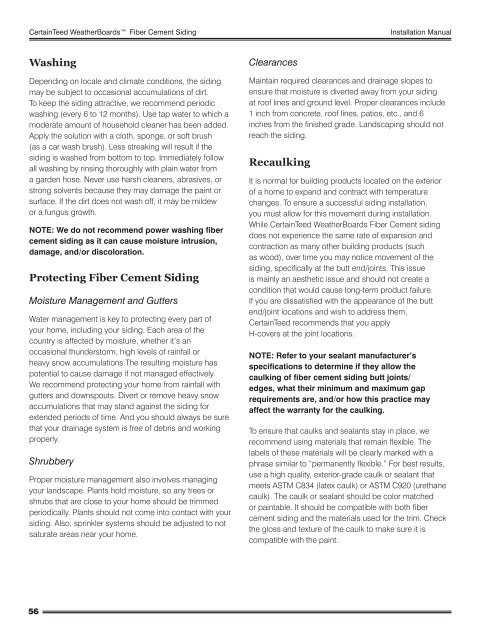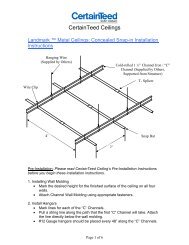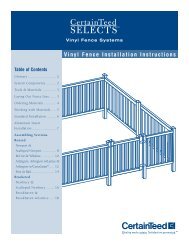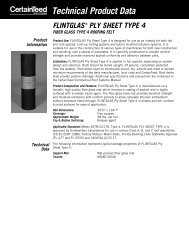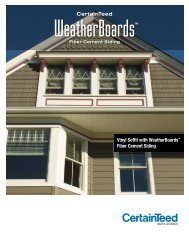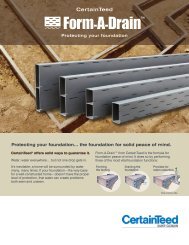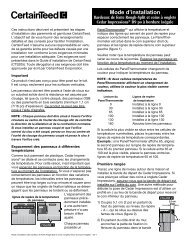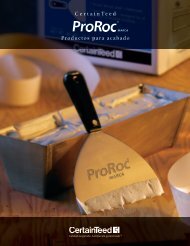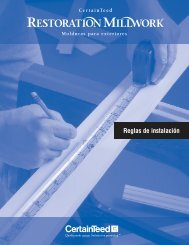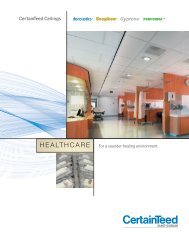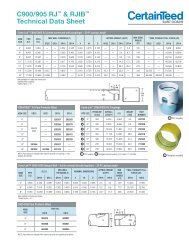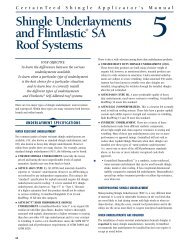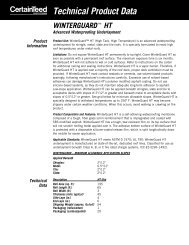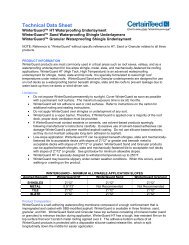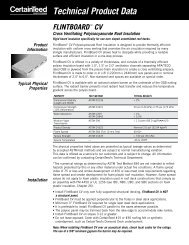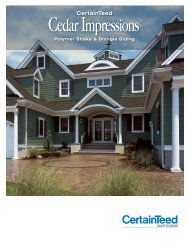Installation Manual - CertainTeed
Installation Manual - CertainTeed
Installation Manual - CertainTeed
Create successful ePaper yourself
Turn your PDF publications into a flip-book with our unique Google optimized e-Paper software.
<strong>CertainTeed</strong> WeatherBoards Fiber Cement Siding <strong>Installation</strong> <strong>Manual</strong><br />
Washing<br />
Depending on locale and climate conditions, the siding<br />
may be subject to occasional accumulations of dirt.<br />
To keep the siding attractive, we recommend periodic<br />
washing (every 6 to 12 months). Use tap water to which a<br />
moderate amount of household cleaner has been added.<br />
Apply the solution with a cloth, sponge, or soft brush<br />
(as a car wash brush). Less streaking will result if the<br />
siding is washed from bottom to top. Immediately follow<br />
all washing by rinsing thoroughly with plain water from<br />
a garden hose. Never use harsh cleaners, abrasives, or<br />
strong solvents because they may damage the paint or<br />
surface. If the dirt does not wash off, it may be mildew<br />
or a fungus growth.<br />
NOTE: We do not recommend power washing fiber<br />
cement siding as it can cause moisture intrusion,<br />
damage, and/or discoloration.<br />
Protecting Fiber Cement Siding<br />
Moisture Management and Gutters<br />
Water management is key to protecting every part of<br />
your home, including your siding. Each area of the<br />
country is affected by moisture, whether it’s an<br />
occasional thunderstorm, high levels of rainfall or<br />
heavy snow accumulations.The resulting moisture has<br />
potential to cause damage if not managed effectively.<br />
We recommend protecting your home from rainfall with<br />
gutters and downspouts. Divert or remove heavy snow<br />
accumulations that may stand against the siding for<br />
extended periods of time. And you should always be sure<br />
that your drainage system is free of debris and working<br />
properly.<br />
Shrubbery<br />
Proper moisture management also involves managing<br />
your landscape. Plants hold moisture, so any trees or<br />
shrubs that are close to your home should be trimmed<br />
periodically. Plants should not come into contact with your<br />
siding. Also, sprinkler systems should be adjusted to not<br />
saturate areas near your home.<br />
56<br />
Clearances<br />
Maintain required clearances and drainage slopes to<br />
ensure that moisture is diverted away from your siding<br />
at roof lines and ground level. Proper clearances include<br />
1 inch from concrete, roof lines, patios, etc., and 6<br />
inches from the finished grade. Landscaping should not<br />
reach the siding.<br />
Recaulking<br />
It is normal for building products located on the exterior<br />
of a home to expand and contract with temperature<br />
changes. To ensure a successful siding installation,<br />
you must allow for this movement during installation.<br />
While <strong>CertainTeed</strong> WeatherBoards Fiber Cement siding<br />
does not experience the same rate of expansion and<br />
contraction as many other building products (such<br />
as wood), over time you may notice movement of the<br />
siding, specifically at the butt end/joints. This issue<br />
is mainly an aesthetic issue and should not create a<br />
condition that would cause long-term product failure.<br />
If you are dissatisfied with the appearance of the butt<br />
end/joint locations and wish to address them,<br />
<strong>CertainTeed</strong> recommends that you apply<br />
H-covers at the joint locations.<br />
NOTE: Refer to your sealant manufacturer’s<br />
specifications to determine if they allow the<br />
caulking of fiber cement siding butt joints/<br />
edges, what their minimum and maximum gap<br />
requirements are, and/or how this practice may<br />
affect the warranty for the caulking.<br />
To ensure that caulks and sealants stay in place, we<br />
recommend using materials that remain flexible. The<br />
labels of these materials will be clearly marked with a<br />
phrase similar to “permanently flexible.” For best results,<br />
use a high quality, exterior-grade caulk or sealant that<br />
meets ASTM C834 (latex caulk) or ASTM C920 (urethane<br />
caulk). The caulk or sealant should be color matched<br />
or paintable. It should be compatible with both fiber<br />
cement siding and the materials used for the trim. Check<br />
the gloss and texture of the caulk to make sure it is<br />
compatible with the paint.


